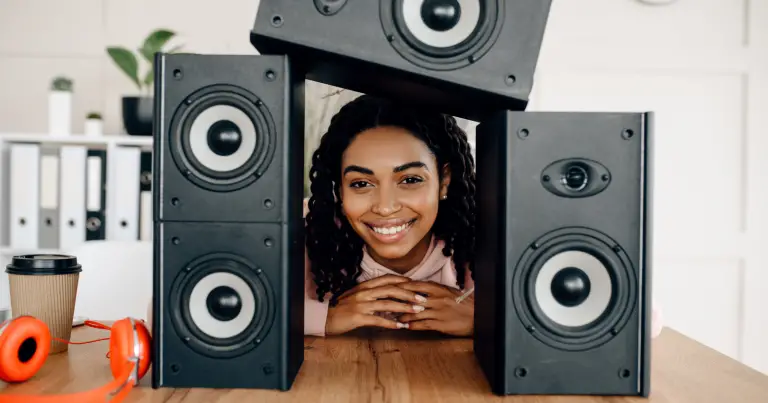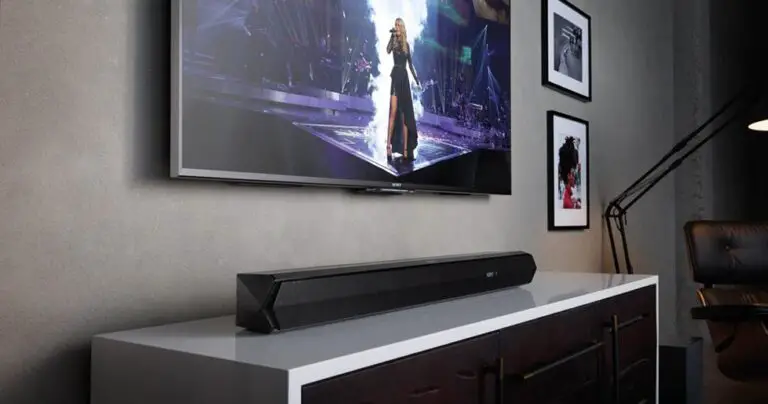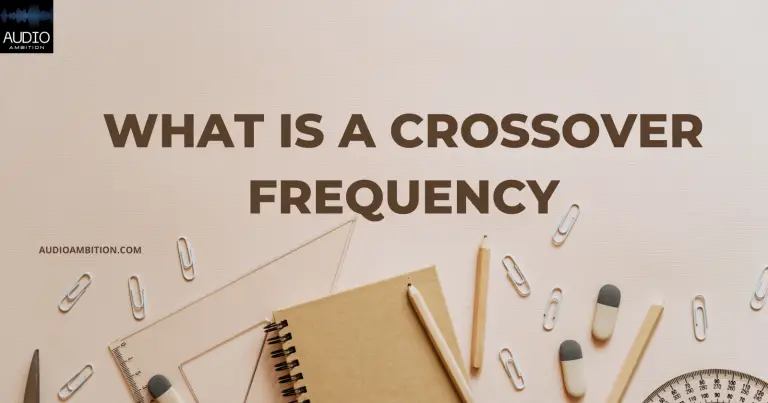Have you recently bought a new TV, but the sound is lacking? A soundbar is a cost-effective, easy way to improve your TV’s sound. In this article, we are going to take on the popular soundbar controversy JBL 9.1 vs Sonos Arc.
WHAT IS A SOUNDBAR?
A sound bar is a speaker that attaches to your TV or is built into your TV. It amplifies sound from the TV so you can hear it better. Soundbars are a great way to fix the audio in your living room. They’re sleek and unobtrusive and offer plenty of power for TVs, gaming consoles, and more.
Design and materials: JBL 9.1 vs Sonos Arc
Sonos Arch is 114 cm long. And, so to speak, it’s almost as big as the longest side of a 50-inch TV.
For this, the first piece of advice I would like to give you is to imagine buying it only if you have a TV of at least this diagonal. The design is minimalistic, with no frills, showing a rounded bar, very long, made of aluminum, wrapped in a metal mesh on each side.
Nothing fancy, nothing flashy, typical Sonos style. The soundbar can also be hung on the wall, but with an accessory that can be purchased separately, and basically, it combines two main ports, one for the power supply and one for HDMI.
‘Thoughtful’ is a pretty good way to describe Bar 9.1’s design. “Wow” might work just as well. It’s hard to imagine an easier way to achieve true surround sound.
The soundbar itself has a modular design and is made up of three parts. The center section is about 88 cm long, and there is a detachable module about 17 cm long at both ends – they attach to the large center section with pretty powerful magnets.
The center section of the soundbar features a forward-firing array of four racetrack-shaped midrange drivers punctuated by three 20mm tweeters. At the top of the bar are some carefully angled full-range drivers, delivering the front height channels of a Dolby Atmos soundtrack.
The detachable modules at the ends of the soundbar also feature a 20mm tweeter as well as a full-range upward-firing driver.
Watch this video: JBL 9.1 vs Sonos Arc: KEY DIFFERENCES
Setting process: JBL 9.1 vs Sonos Arc
Connecting the Arc to your TV is not enough to use it fully. Because, like a smart soundbar, everything is controlled through an app that it connects to via WiFi or an Ethernet cable:
it’s the Sonos S2, a new app that the company’s companies have introduced to both the Play Store and the App Store simultaneously with the release of the new soundbar, from which it will be possible to manage all system parameters, including association with one of the digital assistants with which the device is compatible.
And in addition to Google Assistant and Alexa, Sonos Arch It is also compatible with Spotify, Amazon Music, Tidal, and many other online streaming services, which, among other things, can also be controlled by voice and are completely independent of your smartphone.
The Sonos Arch is controlled by the new Sonos S2 app, an app that has been substantially overhauled both in terms of interface and in terms of what’s hidden too much. For those who have already had the opportunity to use the old application of the company.
It is important to know that already from the first use, there have been significant changes both in terms of speed and stability: if in the old version it was possible to stumble upon firmware updates, for example, not successful with the new Sonos App S2, these inconveniences will only be an unpleasant memory.
With the modules attached to the ends of the bar, the JBL mimics the “front/left/right” channels in a surround sound setup, with the four upward-firing drivers bouncing off the ceiling to give the impression of height to the sound.
Take off the modules and they can be positioned anywhere you like – ideally behind your seating position, of course, but everything is fine next to it too. Practically anywhere, really – and then you have two proper rear channels plus height channel information reflected off a different area of the ceiling.
The modules are battery-operated (they charge when attached to the main body of the soundbar), and they come with small magnetic mounts, so there’s no need for wiring, speaker stands, or other unattractive and awkward home theater Gubbins.
The Bar 9.1 forms the ‘.1’ portion of the ‘5.1.4’ Dolby Atmos configuration and aims to emulate a fairly full-size subwoofer. A 25cm, 300-watt driver looks promising on paper – and the sub’s wireless connectivity is also welcome, as at 44 x 31 x 31cm it’s no shrinking purple.
The subwoofer feels only slightly prosaic in its materials, although there’s absolutely nothing wrong with how it’s put together. And the rest of the Bar 9.1 feels really comfortable, has a smooth finish and immaculate construction.
And with a touch greater than 6cm, the soundbar element should sit nicely under pretty much any TV – as long as you don’t get in the way of the upward-firing drivers.
Listening test: JBL 9.1 vs Sonos Arc
At the listening stage, the lack of TruePlay in Android smartphones makes itself felt. Cause? Simple, just turned on and connected the Sonos Arc using the factory settings, one would regret the purchase: the sound is dark, flat, too many mids, not enough lows. In short, a mess.
Fortunately, however, with the latest software update, this problem has been solved, at least partially, but it is by completing the TruePlay optimization that the Sonos Arc changes its face, and probably turns into one of the best soundbars in its price range.
But the question I’m asking myself is this: who doesn’t already have an iPhone, or iPad to be able to run the Sonos S2 app?
However, once the TruePlay optimization is complete, things will change drastically. The timbre is now complete, the bass is present and no longer washed out like it was just turned on (or never updated), and the sound is excellent: the sound quality is on par (if not better) than the Sonos Play: 5, in terms of on Ark precisely in relation to stereophonic spatiality.
The point, however, is that in all Dolby Atmos-compatible soundbars, the criticality of system calibration is always present: and the Sonos Arca is one of the few smart soundbars capable of being compatible with the latest Dolby surround sound technology.
For those not familiar with Dolby Atmos This is a surround sound technique based on 128 sound objects instead of actual channels. Basically, it manages to restore 3D audio by processing Dolby TrueHD, or Dolby Digital Plus (or Dolby Digital) signals.
The differences between them are mainly in the audio resolution: the first is a high resolution and is only available in some types of sources or devices, the other is in a compressed format and is the most popular version, especially in various services. online audio and video streaming.
I have listened to several music tracks, both from Spotify and vinyl (connecting the turntable to a Sonos amplifier), as well as with lossless audio files, and after the latest update, which fixed the problem of bass “croaking”, I was surprised how loud the sound enters the room. And the same effect occurs when viewing files in 4K and DolbyAtmos:
If you position yourself in front of the Sonos Arc, you will be able to appreciate every little sound that is reproduced, which, however, is absent if you leave the room (and this is the TruePlay effect that calibrates the soundbar according to the basic listening position).
If you’re looking for maximum shock and awe from your new Dolby Atmos soundbar, the JBL has to be high on your shortlist. In terms of range, presence, and unfettered volume, nothing at this kind of money can fill a room with sound quite as effectively as Bar 9.1.
With the modules deployed as rear speakers and the automatic calibration process, the positioning of the effects is much more reminiscent of a true Dolby Atmos system than any other soundbar at any price can manage.
The impression of height is convincing, the placement of the surrounding back effects is undeniable, and thanks to this wireless subwoofer, the low-frequency presence is amazing.
With the Dolby Atmos soundtrack to Spike Lee’s Da 5 Bloods being fed via Netflix, the JBL delivers sound of substantial magnitude.
JBL claims a frequency response for the Bar 9.1 system of 34 Hz – 20kHz, and based on that, this seems realistic. The subwoofer dives deep, while at the other end of the frequency range, a well-judged level of brilliance and attack is delivered by a total of five tweeters.
In between, midrange clarity and detail are enough to keep dialogue projected forward and easy to follow. However, once you exceed the linear magnitude of sound that the JBL can handle, limitations quickly set in.
Bass, for example, lacks variation – this subwoofer, while capable of boosting low, is fairly monotonous in its approach.
There’s not a huge amount of nuance or texture in the low frequencies it delivers, and as a result, it rumbles away with little variation. There isn’t much that is positive when starting and stopping individual bass sounds either, and there isn’t much real punch as a result, either.
And when the effects are strong and fast, the opposite end of the frequency range is similarly indistinct. When effects are moving fast, the JBL struggles to keep up, so individual high-pitched events should become an uninterrupted wash of sound.
It’s also not the most dynamic system you’ve ever heard. Oh, it’ll be loud enough – if you want the neighbors to know you’ve just put a grand on a new audio system, they’ll have no doubt.
But there’s not much of a gap between quieter, more contemplative moments and an all-out action overload. And there’s not much sonic variation from what the JBL does, making the midrange (and its important dialogue) much less distinctive and informative than it could be.
So overall, Bar 9.1 is a bit overconfident. When it comes to sheer power and attack, you’ll never miss it – but if it’s a Dolby Atmos-esque sense of three-dimensionality you were hoping for, you might feel a little letdown.
Price: JBL 9.1 vs Sonos Arc
The Sonos Arch is sold at a list price of $899. This figure is definitely not suitable for all budgets and, above all, for all people: for example, the avid audiophile trembles at the sound of the name “soundbar”.
All in all, though, it’s a great product, able to bring both a great TV sound system and a fantastic music player equipped with a smart system to the living room, thanks to Alexa and Google Assistant.
In short, those who work at Sonos have achieved their dual goal fully, even if the absence of DTS might make someone raise their head: don’t worry, adding Atmos decoding is a winning choice.
No other soundbar or soundbar/subwoofer combo beats the JBL Bar 9.1 (approximately 810 euros) when it comes to adding authentic height to a soundtrack or truly placing surround sound effects behind your seating position.
But if you want a little more from your soundbar than just plain sonic size, there are at least a few very worthwhile alternatives.
Discuss the scope and the scale of the JBL
The Sonos Arc, for example, has neither the scope nor the scale of the JBL but precision and dynamics on its side. It doesn’t have a separate subwoofer, so it’s a) not as bassy but b) easier to live with in terms of interior design.
And while it doesn’t throw effects around the room with the exuberance of the Bar 9.1, it’s a more dynamic and characterful listen – for movies and music.
Conclusion: JBL 9.1 vs Sonos Arc

A soundbar is an amazing addition to your tv set for a better sound experience. In this article, JBL 9.1 vs Sonos Arc, we have compared the Jbl 9.1 and Sonos arc for your convenience.






